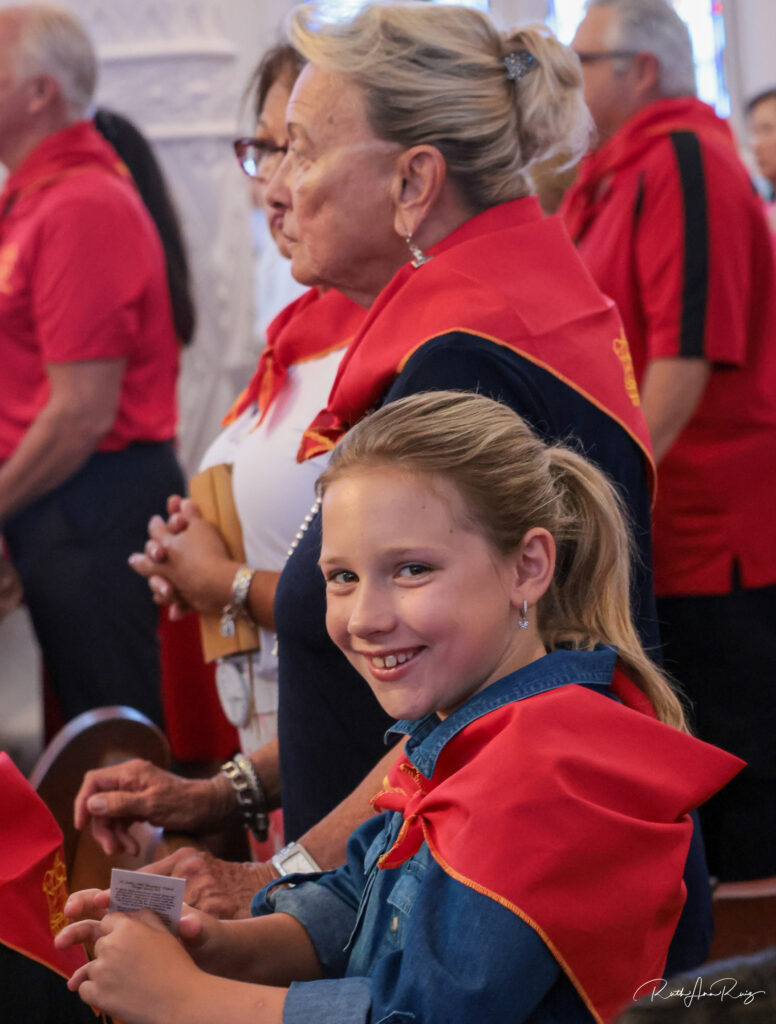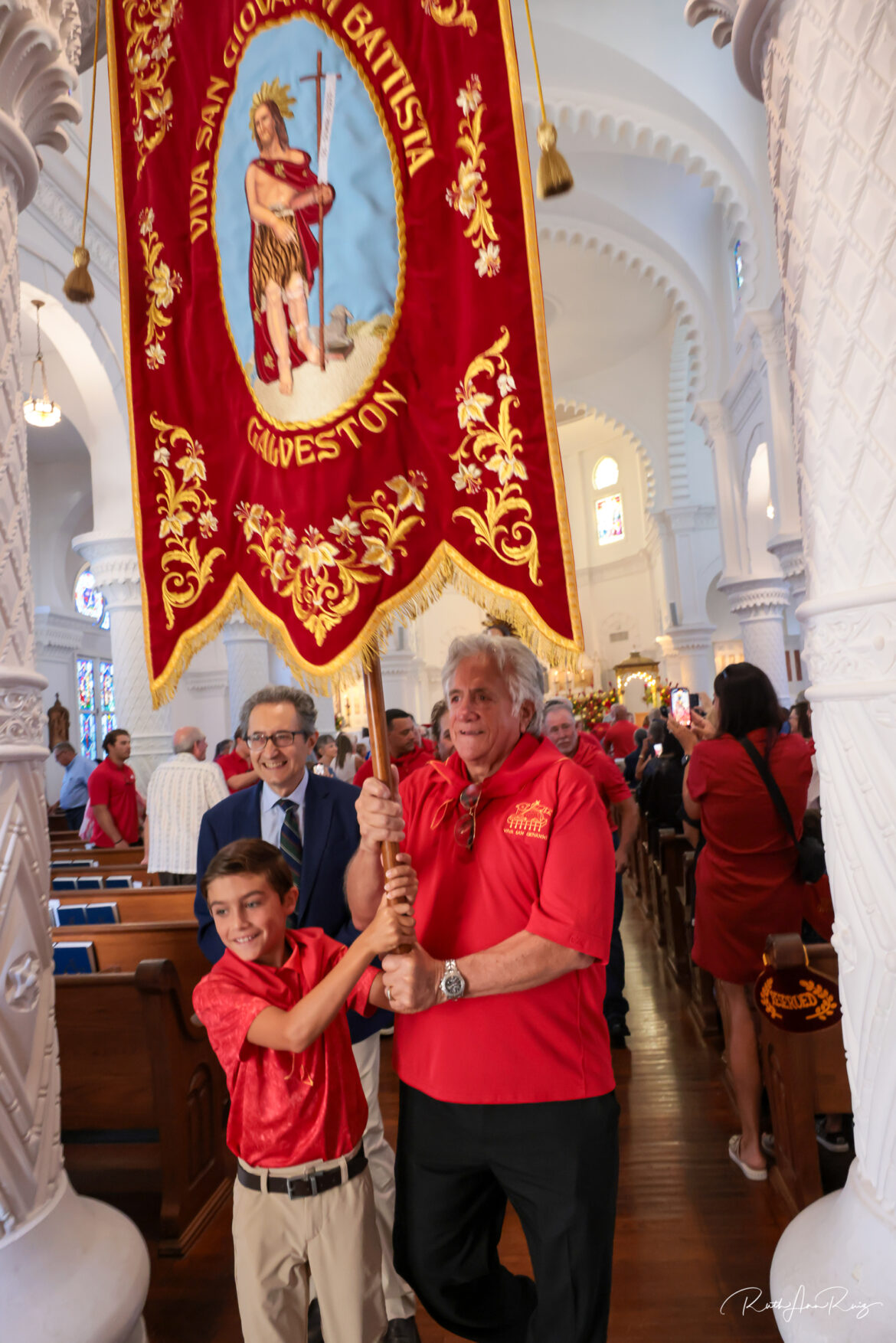
By Ruth Ann Ruiz
The Post Newspaper Features Editor
Young Scarlet is not of Italian heritage. In fact, her grandmother reports their family heritage is Polish, but that didn’t stop both Scarlet and her grandmother from attending the celebration of La Festa di San Giovanni Battista at Sacred Heart Church in Galveston.
June 24 is considered the birthday of St. John the Baptist, also known as San Giovanni Battista, and is celebrated in many ways by Christians around the world. In Galveston, the celebration has been handed down through generations of people of Italian heritage.

The origins of Galveston’s celebration date back to the 1800s in Aci Trezza, Sicily. Galvestonians Angelina Tropea, Grace Lofaro, Lucia Fichera, and Mattea Campanello grew up together in Sicily and brought the tradition to their new island home of Galveston.
As the story goes, in the late 1800s, the men of the city of Aci Trezza were out fishing far from home when a powerful storm with wind and rain caused the seas to become fearsome. It was feared the men would not survive. The women and children of the village prayed to San Giovanni Battista, the patron saint of Aci Trezza.
After several days, the men returned home, and the town was elated. The citizens believed it was a miracle that had saved the fishermen, so they committed to honoring San Giovanni Battista every year on June 24.
It was in 1956 that Angelina, Grace, Lucia, and Mattea committed to continuing their cultural traditions and commissioned a sculptor in Italy to carve a statue of San Giovanni. They collected donations from the many others who believed in their quest.
On June 24, 1957, the first celebration of the festa was held at Sacred Heart Church in Galveston. It included a wooden replica of the beloved statue in Italy.

This year, the feast day fell on a day with blue skies and no rain, and Catholic worshippers and some non-Catholics came to celebrate.
Entering the church, my attention was drawn to the altar. There sat a gold shrine that held the statue of a long-haired man wearing a type of crown on his head. He was clothed with a red throw covering one shoulder, leaving most of his chest bare. From his waist down to his knees, he wore a brown garment. Red and gold flowers surrounded this shrine.
The Mass was celebrated by Cardinal Daniel DiNardo, who reminded those present of the importance of remembering St. John the Baptist, who paved the way for the Lord Jesus Christ.
“We have a model in John the Baptist that is a little rough around the edges,” DiNardo said. “You wouldn’t want to meet him on a street corner in Galveston.” DiNardo went on to explain that many people were drawn to him despite his appearance.
The Bible describes John the Baptist as wearing clothing made of camel’s hair and a leather belt around his waist and eating locusts and wild honey. The Gospels say he spent most of his life living in the wilderness.
Even though John the Baptist isn’t described as looking like someone another person would want to meet on a street corner, the Gospels say that people, including Jesus Christ, were drawn to him. John the Baptist derives his name from being the person who baptized Jesus Christ.
The Sacred Heart Church sanctuary was filled with many people dressed in red or wearing red scarves around their necks. Red scarves with gold embroidery were for sale at the back of the church.
This year’s event drew the attention of Italy’s Consul General in Houston, Mauro Lorenzini, who came from Houston to be part of the celebration. Also in attendance was Galveston County Sheriff Jimmy Fullen.
Though a Mass is usually a somber time of worship and reflection, celebrating San Giovanni brought out an air excitement in anticipation for the events that would come after the Mass.
Once the Mass had ended, it was time to celebrate—Sicilian style.
Men in red shirts came to the altar while the Knights of Columbus lined up in the aisle, and then one of the men stepped up to the statue and began waving a red and gold cloth while loudly proclaiming in Sicilian, “Let us all say together with all our hearts, Viva San Giovanni!”
Fireworks began sounding off as part of the celebration. Though they were being lit outside in the parking lot, the sound reverberated throughout the sanctuary.
The procession, which included seminarians along with the Very Rev. Jude Ezuma, pastor of Holy Family Parish of Galveston and Bolivar; the Rev. Jacob Ramirez, parochial vicar; DiNardo; several deacons; the Knights of Columbus; and men in red who carried the statue, began making their way rather quickly down the main aisle of the church while the congregation followed behind.
Once outside, the celebration continued with more fireworks that did not go into the air but rather displayed flashes of light on the pavement of the parking lot. The fireworks contributed to the party spirit with their bangs and pops. The air near the church was wrapped in a light layer of smoke.
As is tradition, the procession continued to make its way around the church and onto the sidewalk and then back to the front of the building. There, attendees were waiting for the joyous return of the men and the statue.
Alfio Tropea, who is of Sicilian heritage, explained that the celebration in Aci Trezza lasts for one month.
“Our small procession is a small representation of what they do in Italy,” Tropea said. “Over there, thousands and thousands of people attend, and there is a lot of emotion expressed. In Aci Trezza, they also honor the day John the Baptist was martyred on August 29.”
Tropea is working to maintain the authenticity of the celebration. The gold shrine was made in Galveston and is a near replica of the one in Sicily. The banner was specially ordered from outside of the United States and is made with gold and silver thread. The men’s shirts are very similar to the shirts worn by men in Italy during the festival.
“The red scarves everyone was wearing were handmade in Aci Trezza with yellow golden embroidery of the Lamb of God. They are taken into the church and blessed by the pastor, and then they’re shipped to us directly,” said Tropea.
As a first-time attendee at a Festa di San Giovanni Battista, I felt, for a moment, that I too must be of Italian heritage. But alas, I am not.

